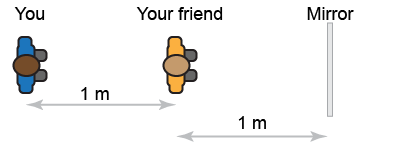- A ray of light hits a mirror at an angle of 72° to the normal. What is the angle of reflection?
- 28°
- 72°
- 144°
- 180°

- A friend and you are looking in a large, flat mirror against a wall. The friend is 1 m away from the mirror and you are 1 m directly behind her. How far are you from the image of your friend in the mirror?
- 0 m
- 1 m
- 2 m
- 3 m
- What property of light explains the formation of shadows?
- Light travels in straight lines.
- Light has different colors.
- Light has wave and particle properties.
- Light can change direction.
 Which of the following are properties of the images formed by a plane mirror? Which of the following are properties of the images formed by a plane mirror?
- The image is located behind the mirror.
- The image distance is equal to the object distance (although it may be negative).
- The image reverses left and right.
- The image is smaller than the object.
- I and II only
- II and III only
- I, II, and III only
- I, II, III, and IV
- Which of the following optical devices uses refraction?
- mirror
- lens
- prism
- I only
- II only
- I and II only
- II and III only
| | - What is the best choice in the following list for mounting a laser pointer to a ring stand?
- a ring clamp
- a 90° rod clamp
- wood glue
- nylon string
- A 20-cm-wide image is seen through a compound system with a magnification of 2.5. What is the width of the subject?
- 8 cm
- 20 cm
- 30 cm
- 50 cm
- A man is standing 2 m in front of a flat mirror and facing the mirror. How far away from him is his image located?
- His image is located at his location, i.e., 0 m away.
- His image is located 2 m in front of him.
- His image is located 4 m in front of him.
- His image is located 2 m behind him.

- The curved mirror depicted has a focal length of 10 cm. Which point on the number line is the center of curvature?
- A
- B
- C
- D
- E
- For which of the following would a ray diagram be useful?
- predicting where a shadow will appear for an object held under a light source
- representing the electronic circuitry of a lamp
- displaying the path of light in a periscope
- I only
- I and II only
- I and III only
- II and III only
- Which kind of mirror can create an image that is larger than the object?
- a flat mirror
- a convex mirror
- a concave mirror
- None of the above is correct.
|

